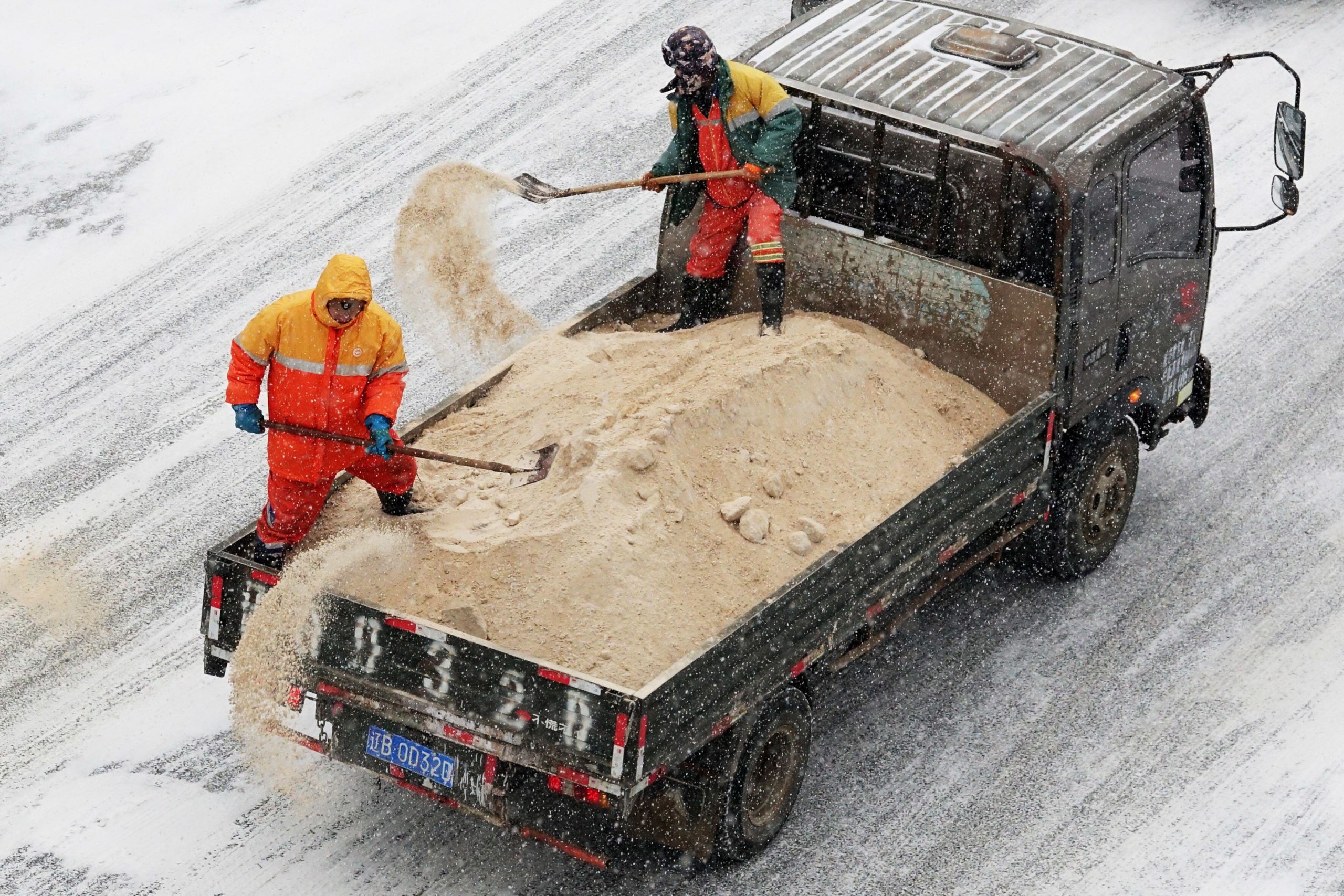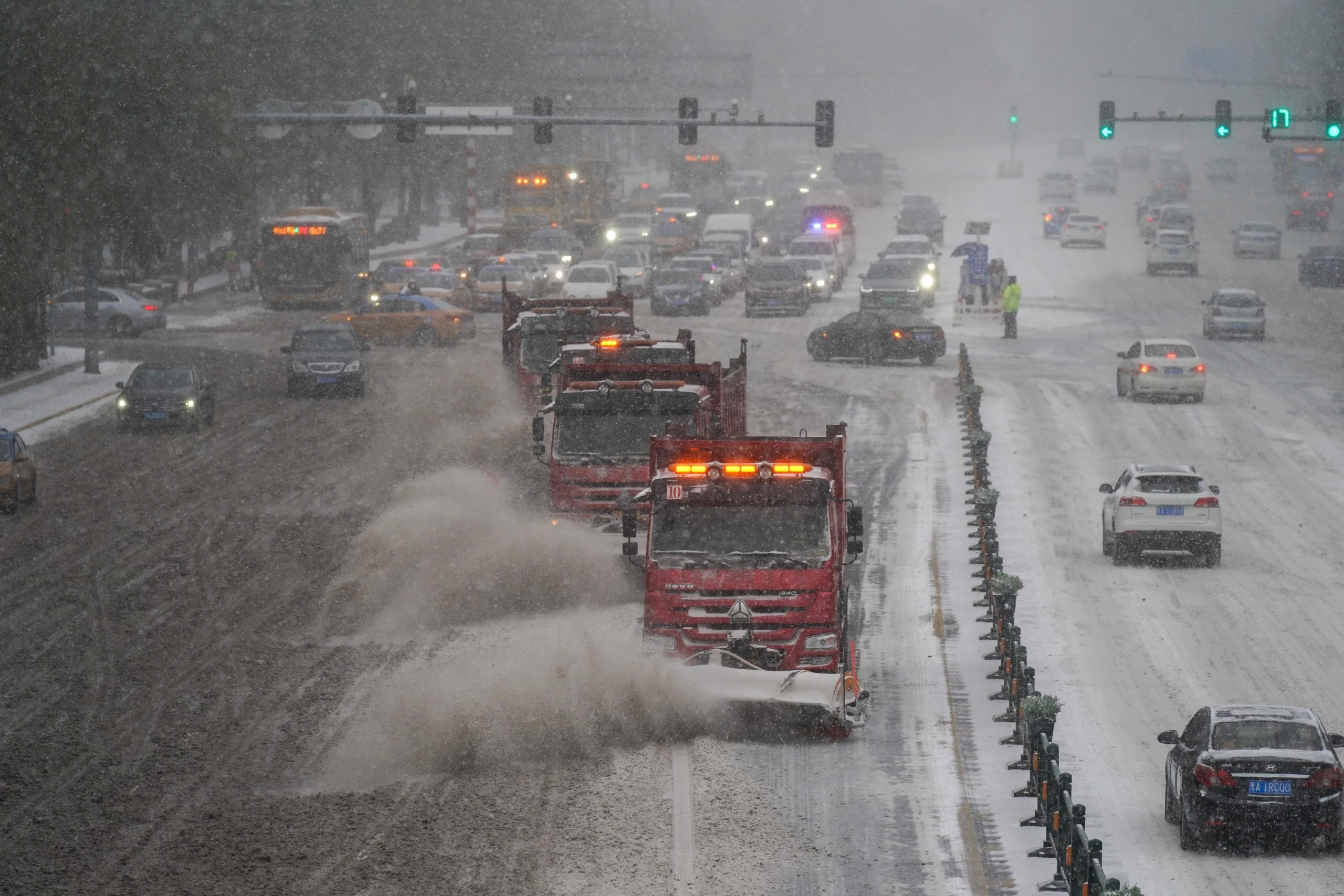Road salt: Protecting China’s drivers, but at what cost? (chinadialogue.net)
Salting roads can make winter driving safer, but its corrosive impacts on roads and human health need addressing

Road salts can contaminate drinking water sources and harm animal and plant life (Image: Alamy)
In January, potholes began appearing on Dalian’s roads after heavy snowfalls. Residents of the north-eastern Chinese city even reported hearing their chassis strike the highway.
The local government admitted that widespread use of road salts for snow clearance is a cause of the damage.
Road salts – usually called “snowmelt agents” in China – prevent ice forming on the road by lowering the freezing point of water. Pure water becomes ice at 0C, but when combined with salt, this threshold can drop to around -10C.
Sprinkling salt on roads is a common practice in colder climates. It’s estimated that globally over 66 million tonnes are used for de-icing every year.
The use of chloride salts on roads has long been controversial because of their well-documented impacts on the environment, ecology and human health.
While environmentally friendly alternatives remain elusive, experts suggest seeking ways to reduce salt use, such as through more efficient spreading methods.
Environmental and health hazards
Potassium acetate and chloride salts are the most common snowmelt agents. While potassium acetate is an effective de-icer and causes less corrosion, its high cost means it is generally only used on airport runways.
Chloride salts (such as sodium, calcium, and magnesium chlorides) are almost one-tenth the cost, and are tend to be used on regular roads. But their corrosive effect on cars and roads is a major problem. As an example, Beijing’s Xizhimen overpass, which opened 20 years ago, has already experienced severe concrete spalling and steel corrosion partly because of chloride salts.
Cars and safety are also impacted: chloride ions damage the external protective layer of metal components in car chassis and accelerate tyre ageing. In China, from 2005 to 2020, car companies recalled and repaired 430,000 vehicles due to chloride salt corrosion.
Moreover, chloride salts increase the salt concentration of water sources and soil. This affects the growth of roadside plants, and can even lead to their wilting and death. For instance, in Beijing in 2005, over 11,000 street trees, 1.49 million shrubs and almost 200,000 square metres of grass suffered severe salt damage or death, resulting in direct economic losses of more than 30 million yuan (US$4.2 million). Salt concentrations in residual roadside snow and surrounding soil were found to be 392 times higher than normal.
As early as 2006, China’s central government published the “Technical specifications for snow removal operations on city roads”. It stipulated that snowmelt agents should be kept within 1 metre of roadside verges that contain plants. Rather than being piled into tree pits or onto grass, ice and snow that had been exposed to such agents should be transported and treated separately, the document stated.
Yet in practice these regulations have been poorly implemented. In 2022, the media reported the death of roadside plane trees in Beijing on a large scale. Professor Liu Yong, of the College of Forestry at Beijing Forestry University, explained that the trees died of desiccation after absorbing snow – and snowmelt agents – pushed onto their roots by roadsweepers.
Snowmelt agents can also harm the health of humans and other animals. As snow and ice contaminated with chloride salt melts, the salt can wash into the surrounding soil, as well as lakes and streams, possibly contaminating reservoirs and drinking water wells. High sodium levels in drinking water can negatively affect people with high blood pressure, while high chloride levels in surface water are toxic to certain types of fish, insects and amphibians, states the US Environmental Protection Agency.
Chinese state media CCTV reported that, after the devastating winter storms of 2008, residents of villages along the Beijing–Zhuhai expressway reported issues with drinking water quality, with some experiencing fever, vomiting and other symptoms. Investigations identified the cause as heavy use of snowmelt agents on the expressway, with excessive chloride ions entering the nearby spring that supplies the area’s reservoir.
China Dialogue spoke to Victoria Kelly, Environmental Monitoring Program manager at the Cary Institute of Ecosystem Studies. She explained that chloride salts have long been employed as snowmelt agents. Their use in the US can be traced back to the 1940s, but it wasn’t until the late 1960s and early 1970s that scientists discovered their presence in rivers, lakes and groundwater, and began to discuss their effect on the environment. To date, thousands of scientific papers have been published on the impact of chloride salts on bodies of water, organisms and ecosystems, and a growing number of researchers are calling on policymakers to reduce their use, said Kelly.
Can chloride salts be replaced?
Despite growing awareness of the harmful environmental and health effects of sodium chloride salts, their “sheer cost-effectiveness has led to their ongoing widespread use”, Kelly said.
In China, there are no definitive statistics on chloride salt usage on roads. In the US, Kelly said that while national-level data is available, there are gaps in data at the local level. She believes that governments around the world need to strengthen monitoring of chloride salt usage on roads and publicly disclose usage data.
In the meantime, there have been efforts in China to minimise harm from snowmelt agents. Over the last decade or so, some cities have been raising standards on their composition, as well as promoting what they deem to be environmentally friendly alternatives on a small scale.
The standard is a recommendation rather than mandatory. In practice, each province and city has introduced its own requirements for “environmentally friendly” snowmelt agents. For example, Shenyang City proposed the optimal ratio of sodium, calcium and magnesium chlorides in chloride agents as 4:3:3, while Jilin City requires the entire municipality to use “environmentally friendly” non-chloride salt agents.
In 2002, Beijing enacted China’s first local standard for “environmentally friendly” snowmelt agents, stipulating that salt sold for use on Beijing’s roads must be less than 50% as corrosive as pure sodium chloride. Since the 1970s, snow and ice had been removed from Beijing’s roads by spraying salt water, that is, pure sodium chloride in liquid form. After the introduction of the standard, 14 types of calcium chloride and magnesium chloride agents replaced this more-damaging salt water.
Treating roads with a salt solution prior to a snowstorm can reduce salt use by 75%
However, these replacements are still chloride salts. They can harm soil and greenery, and their environmental protection credentials have been questioned. In 2017, the country updated the 2002 standard with a new edition clearly dividing agents into chloride and non-chloride. It stipulated that the chlorine content of non-chloride organic agents must not exceed 1%.
In 2015, some districts in Beijing began promoting snowmelt agents made from fermented straw, claiming they are less corrosive than common snowmelt agents on asphalt pavements and bridges, while also protecting roadside vegetation.
Kelly said she was unable to comment on whether straw agents were an effective solution but observed that, generally speaking, it was difficult to find truly “environmentally friendly” agents.
Some food-based alternatives have been attempted elsewhere. In Canada, the city of Calgary and some parts of British Columbia have been experimenting with beetroot juice. While the US state of Wisconsin is spreading cheese brine on its roads. But these agricultural by-products are often more expensive and carry their own environmental dangers. Beetroot juice, for example, can disrupt the nutritional balance of wetlands when it enters water bodies.
Reduce salts and adopt alternatives
Before novel snowmelt agents with clear environmental advantages and low production costs are developed, chloride salts will continue to be used on roads. Many researchers have therefore been exploring how to minimise the quantity used while still ensuring driver safety.
China’s “Technical specifications” regulate the quantity of snowmelt agent that can be spread. When a snowfall event does not exceed 10mm, the amount used must not exceed 10 grams per square metre. This is the basis on which northern provinces have adopted further measures to reduce usage, scope and duration of snowmelt agents.
Harbin carefully re-categorised its 2,453 roads, restricting snowmelt agents to sloping roads and important traffic intersections. In Shenyang, 29 roads were selected for purely mechanical snow removal.

Snow plow trucks clear the road during a winter storm in Harbin, 2023. Due to environmental concerns, the city has restricted snowmelt agents to sloped roads and major intersections. (Image: Alamy)
The Shenyang municipal administration told the media in 2011 that the most important thing is to only use road salts where it is demonstrably needed. The second is to use environmentally friendly agents wherever possible, and the third is to use more mechanical and manual means of snow removal.
When presented with these cities’ approaches, Kelly agreed with them. She also highlighted Cary Institute reports indicating that treating roads with a salt solution prior to a snowstorm can reduce salt use by 75%.
Striking the right balance between ensuring road safety in winter and protecting roadside vegetation, groundwater and human health requires coordination across multiple sectors, Kelly noted. It also needs a shift in public perception towards accepting reduced salt use, or salt alternatives, as still safe, she said. “The important thing is that governments communicate with the public about the environmental impacts as well as the road safety issues of road salt.”
